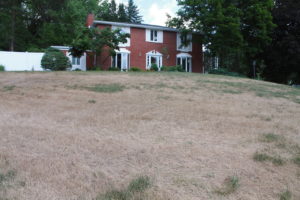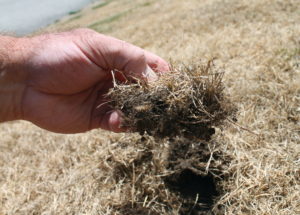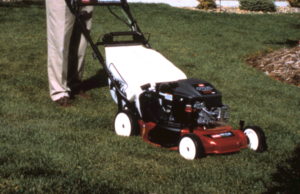My Lawn Strangled Itself
August 18th, 2020
A lot of lawns went brown during the weeks-long hot, dry spell in July.
That’s normal and is a lawn’s way of “hiding out” in survival mode until conditions improve.
A good rain or two typically brings a lawn out of summer dormancy, and it goes on to green up and start growing again.
Not my lawn.
About a third of it is dead, and I know what happened.
Thatch.
Thatch is a spongy layer of mostly dead grass stems and roots at the top of the soil. It’s normally a quarter- to half-inch thick and is useful for insulating the soil from temperature extremes and cushioning impact when we walk or play on a lawn.
But when this thatch layer builds up faster than it’s breaking down, it can grow to levels that impede oxygen and rain from reaching the soil underneath.
Anything more than an inch thick is trouble.
I wasn’t too worried when big sections of my full-sun, sloped front yard starting going brown in June. It got browner quicker than a lot of other lawns, including my own lawn in the back yard.
However, I’d seen lawns stay brown for four weeks or more, then bounce back completely after a single soaking rain.
When we finally got a soaker toward the end of July, some of my front lawn showed green. Another rain that dropped nearly an inch a week later caused about two-thirds of the lawn to start growing again.
Yet two huge swaths and a few other smaller patches stayed brown as straw at Halloween.
It was too early for grub damage, and the solid sheets of death didn’t add up to the more circular, patchy dead appearance of summer lawn diseases like brown patch and summer patch.
So I got out a trowel and dug down to hunt for signs of life and clues.
What I found was a two-inch-thick thatch layer blanketing the dead areas. This was way more than I ever had on my old Cumberland County lawn.
I suspect thatch was soaking up what little moisture fell since April, preventing it from getting down to the actual soil.
I found no roots under the thatch, which told me the grass had been growing in the thatch. And when that dried out and heated up in July, the roots died. There’s no sign of life.
My thatch theory is consistent with how the lawn did fine all of last summer. Because of the regular rain then, the grass growing in the thatch stayed damp enough and cool enough to survive summer.
My only recourse now is to rent a dethatching machine to tear up and remove the thatch, then reseed the bare areas.
It’s going to be another labor-intensive project at a house that’s been one unending repair job after another.
If you have grass that went brown this summer, and it isn’t greening back up, you might want to check the thickness of your thatch. Don’t just assume it was the heat alone or it needs more fertilizer.
Excess fertilizer is actually one of the leading causes of thatch, according to Penn State’s Center for Turfgrass Science.
If you push growth too much with four or five or even six applications of nitrogen-rich fertilizer, the lawn can produce more roots and stems than soil organisms can break down.
Some other thatch causes that Penn State cites:
* Thatch-prone species. Some grasses are naturally more prone to thatch buildup than others. Running grasses such as Kentucky bluegrass and creeping red fescue, for example, are more likely to run into excess thatch than clumping perennial ryegrass and tall fescue.
* Lousy soil. Clayish or compacted soil is typically low in the soil microbes that break down thatch. Acidy soil (below 5.5 on the pH scale) also doesn’t support rich colonies of these important microscopic helpers.
* Pesticides. Many insecticides kill both soil microbes and earthworms that help break down thatch and aerate the soil. Fungicides can be detrimental by leading to excess production of roots and grass rhizomes, which can accumulate faster than old ones break down.
* Frequent light watering. Lots of shallow irrigating encourages roots to stay high up in the soil surface, where they’re more susceptible to heat injury… and drought injury if you stop irrigating. Those dead roots contribute to a growing thatch layer.
One thing that doesn’t cause thatch is letting your grass clips fall into the lawn instead of bagging them. In a healthy lawn with a thin thatch layer, these surface clips break down quickly and easily (and return nutrition to the lawn in the process).
Besides smothering lawns by denying air and rain, thatch can increase pest problems by harboring populations of disease-causing organisms and insects, Penn State adds.
You might even unknowingly be cutting your grass too short – possibly down into the crowns – when your mower wheels sink into that soft thatch layer.
I don’t know the history of my inherited lawn to zero in on the exact causes.
For sure, though, the soil is very heavy and compacted – as if in the first stage of becoming coal. I might have to aerate in addition to dethatching.
Once I get the thatch out of the way, I’m going to use the opportunity to improve the quality of the lawn.
Rather than buying the cheapest seed I can find (the way most people pick their grass seed), I’ll be consulting Penn State’s latest grass-variety trials and seeking out the best types I can find online.
If you’re in the market for grass seed this fall, you can find trial results from universities all over the U.S. on the National Turfgrass Evaluation Program website.
September is our best month of the year for all of the above lawn work.
For more thatch information, check out Penn State’s fact sheet on the subject.










